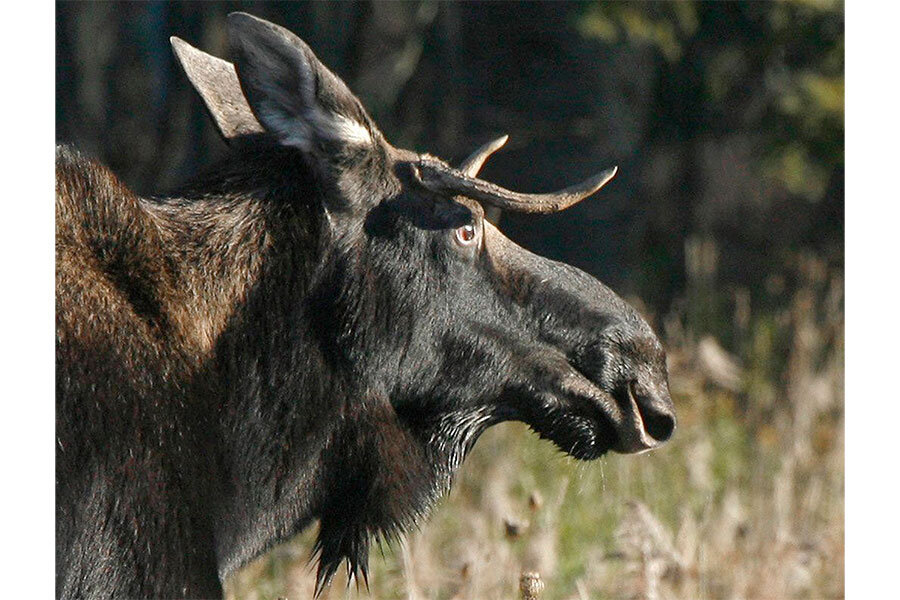Do we need a 400-mile hiking trail inspired by Alice the Moose?
Loading...
In 1998, a 700-pound female moose was radio-collared and released into Huntington National Forest in New York State’s Adirondack Park. Nicknamed Alice, she travelled over 350 miles, crossing the Saint Lawrence River and the Canadian border into the Algonquin Provincial Park in Ontario, where she died of unknown causes. Her journey highlighted the potential of an unimpeded path of travel between the two major parks.
Inspired by Alice’s journey, the A2A Collaborative, named for the two anchoring parks, the Algonquin and the Adirondack, began shaping the idea of a dual-purpose path through 400 miles of wilderness that would serve as both a corridor for wildlife and trail for hikers.
Wildlife corridors have become popular in the past few decades as ways of facilitating greater roaming by certain animal species to help them eat, mate, and breed. According to the National Wildlife Federation (NWF), a conservational advocacy constituency established in 1936, North American animals such as moose, lynx, black bear, and bobcats especially benefit from having large areas to roam. Otherwise, fragmentation by roads and other man-made obstacles kill thousands of animals as they seek food, water, and safe cover for breeding.
The specific corridor proposed by the A2A Collaborative is notable because the route is based entirely on that of one travelled by a single large, radio-tracked mammal: Alice the Moose.
The NWF believes that by providing safe passages around major manmade obstructions benefits the local human populations as well. According to the NWF, the National Highway Traffic Safety Administration reported that animal-related vehicular accidents cause an average of 165 human deaths and cost $1 billion annually in property damage.
And the A2A Collaborative wants to take the society-focused benefits even further. Inspired by a 375-mile section of the Camino de Santiago trail, which runs from the Pyrenees through small towns and villages in the Spanish countryside and directly boosts tourism revenue, the A2A Collaborative argues that the proposed 400-mile trail spanning a national border and connecting two major North American parks would similarly benefit towns in northern United States and southern Canada.
But the creation of any major hiking trail comes with a great deal of challenges. For example, the Appalachian trail, which was initially proposed in 1925, didn’t acquire the last and final stretch of land until 2014, almost 100 years later. Major issues on trail creation come from gathering funds for land acquisition and negotiating the purchases as well as the construction of the trail itself.
According to David Miller, the executive director for the A2A Collaborative, gathering financing is a particular challenge, as many funders limit their spending to one side of the border or another. As a result, the majority of their funding has been largely collected thus far on the Canadian side, while relying on volunteer efforts for the US portion.
Inherent legislative difficulties exist as well. “The agency government structures [between the US and Canada] are of course different so it means taking slightly different approaches,” says Mr. Miller, who added that they have so far progressed further with their government outreach on the Canadian side.
Other wildlife corridors have run into similar challenges. Gathering land and creating international conservational collaborations always runs the risk of finding logistical and political complications. A conceptually similar project, the Yellowstone to Yukon (Y2Y) Conservation Initiative envisions an “interconnected system of wild lands and waters stretching from Yellowstone to Yukon, harmonizing the needs of people with the needs of nature,” according to their website. The project, which began in 1993, spans five American states, two Canadian provinces, two Canadian territories, and several areas owned by government agencies and native populations.
While the majority of scientists believe in the practice of creating wildlife corridors, others argue that the fragmentation of species can at times benefit certain ecosystems and the creation of corridors promotes the spread of predators and diseases into ecosystems previously protected by their isolation.
In a 2011 article for Environment 360 at Yale University, journalist Jim Robbins acknowledges that although few studies have been performed on the conservation effect of corridors on large animals, the improvement on small-to medium-sized species prove the effectiveness of corridors on overall population health. Mr. Robbins, along with the majority of scientists, argue that such corridors are a beneficial effort towards species protection. And Y2Y even has a page on their site dedicated to showing the consistently closing gap between the grizzly populations located in the two respective parks.
It is true that as of yet no major project has aimed to combine a wildlife corridor with a major hiking trail, and such a concept does bring added considerations and complications, the overall concept of connecting regional human cultures while facilitating safe roaming for animals makes the A2A Collaborative unique.







